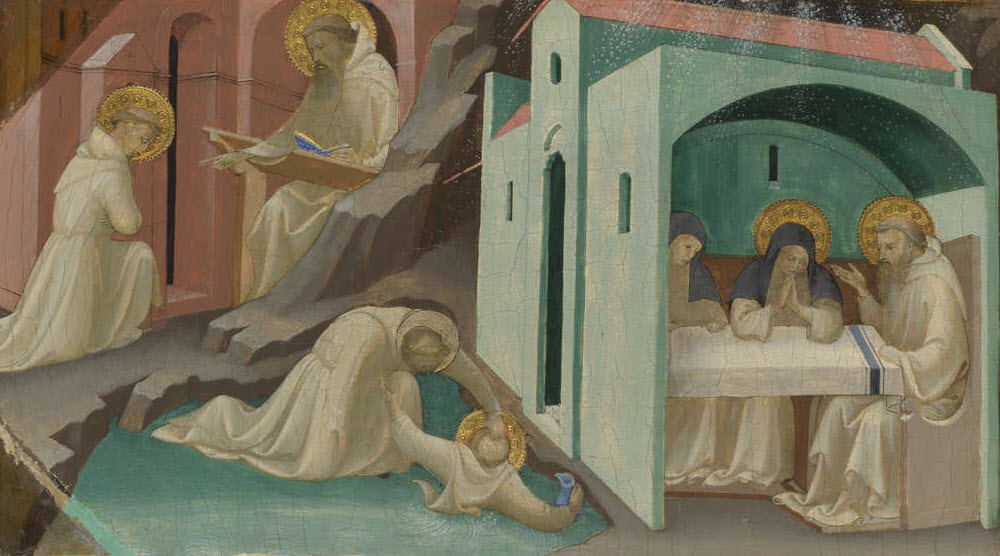
Having spent a good many years as a member of a new monastic community, I had anchored my early experience in a sometimes misguided hope. I often—though unconsciously—presumed that such an intentional life, guided by a Rule, would transform its practitioners into paragons of virtuous charity and spiritual perfection through a kind of spiritual osmosis.
Wisdom proved otherwise with the course of time, and I began to understand that commitment to a particular way of life could—indeed—be immensely transformative and life giving. But the “osmosis” I presumed was not a universal given, nor did spiritual growth always look the same.
Inspiration in the Annals
I struggled to understand the disillusioning fragments of human frailty and failure as I discerned stepping away from my own community. Quite unexpectedly, I found a paradoxical source of inspiration in the annals of monastic history. The perpetual alternations of wisdom and folly I found there was a mirror of humanity, extraordinarily hope-filled at times and abysmally desperate at others.
Providentially, during this critical time of growth and discernment I became a student of Sister Ann Kessler, a Benedictine nun-historian who had made telling the story of monasticism her life’s work. Returning from numerous research forays to monastery libraries and archives around the world, she continued to share her extensive knowledge for over five decades at Mount Marty College as Professor of History, social activist, politician, and now retired monastic historian.
Benedictine Roots & History
During her active career, a number of Sister Ann’s students, monastic formation directors, and other academics persuaded her to collect her varied manuscripts, lecture notes, and illustrative handouts that accompanied her courses, lectures, and seminars into a book. Published by Sacred Heart Monastery in 1996, Benedictine Men and Women of Courage: Roots and History came to life as a detailed description of the development of the Order of Saint Benedict. The book presented an inclusive and comprehensive history finally available for its eager readers, uniquely interweaving the histories of both monks and nuns.
Called “monumental” by monastic historian Esther De Waal (2001, p. 162), the publication had long sold out and was no longer in print despite its demand. As a student, I meticulously photocopied the library’s volume for my coursework, and later digitalized—with the help of a near-heroic work-study study student of mine—its 540-plus pages. With Sister Ann’s permission, I placed the book for free download on the Web, not realizing I was destined to spend nearly a full year—over a decade later—extensively editing and revising the book into its new, more readable form.
The time had come for this important work to not only resurface, but to be made much more widely available. As I have written in the books’ new Preface, the book Benedictine Men and Women of Courage: Roots and History, Revised Edition (2014)
invites Benedictines and non-monastics to comprehend our present through the lens of both favorable and tragic past events, personalities, and contexts that continue to ground our present and shape our future. Sister Ann’s tireless zeal for monastic history and its implications for life within both the monastery and the world make this book a timely outpouring of love, caution, and possibility.
As Laura Swan, OSB writes in her Foreword to the Revised Edition,
People are looking anew at the possibilities of Benedictine spirituality and the monastic way of life. Intentional communities based on the Gospel, a Rule of Life, and with a commitment to works of justice continue to emerge. These new communities and traditional monastic communities are connecting. Families are basing family life and the raising of children on the Rule of Benedict. Increasing numbers of people are becoming oblates, bringing the wisdom of Benedict to their communities.
Beyond the urgency of this drive for connection, new contexts and questions arise. Monastic life continues an archetypical call to a deeper wisdom (Panikkar, 1982).
Deeper Roots, Emerging Wisdom
The appeal of the monastic values of grounded place, welcoming openness, and contemplative action transcends religious affiliation to reveal an intrinsic longing to lay down roots in the rich spiritual soil of an ancient lineage.
A life-encompassing Rule exerts its power in unexpected ways and places, without regard to its varied interpretations. The divergent response to “race along the way” (RB Prologue 49) makes the fifteen centuries of Benedictine change, decline, restoration, and renewal discussed in this book worthy of its new edition.
During years of an uncertain caution, I was called to consider new possibilities. Knowledge of monastic history had opened me to the complex unpredictability of the spiritual life. No longer an “osmotic” certainty, transformation takes shape differently across centuries, cultures, and individuals. It occurs in the presence of crisis and disillusionment, of banishment, censure, and annihilation as well as in the stable quietude of daily lives of prayer and work.
To order Benedictine Men and Women of Courage: Roots and History, Revised Edition and for more information, please visit the book website.
__________________________________
References
De Waal, E. (1984/2001). Seeking God: The Way of St. Benedict. Collegeville: Liturgical Press.
Kessler, A. (1996). Benedictine Men and Women of Courage: Roots and History (1st edition). Yankton, S.D.: Sacred Heart Monastery.
Kessler, A., & Kelly, N.A. (2014). Benedictine Men and Women of Courage: Roots and History, Revised Edition. Seattle: Lean Scholar Press.
Panikkar, R. and North American Board for East-West Dialog. (1982). Blessed Simplicity: The Monk as Universal Archetype. New York: Seabury Press.
